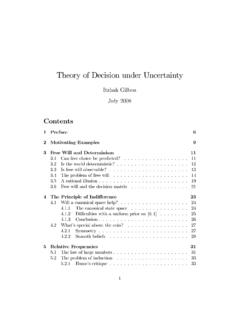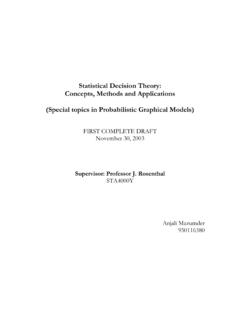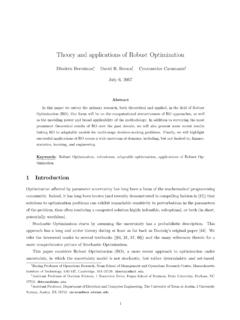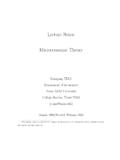Transcription of Reducing risks, protecting people - HSE: …
1 Reducing risks ,HSE s decision -making processprotecting peopleReducing risks ,HSE s decision -making processprotecting peopleHSEBOOKSREDUCING risks , protecting PEOPLEHSE s decision -making processii Crown copyright 2001 Applications for reproduction should be made in writing to:Copyright Unit, Her Majesty s Stationery Office, St Clements House, 2-16 Colegate, Norwich NR3 1 BQFirst published 2001 ISBN 0 7176 2151 0 All rights reserved. No part of this publication may be reproduced, stored in a retrievalsystem, or transmitted in any form or by any means (electronic, mechanical, photocopying,recording, or otherwise) without the prior written permission of the copyright 1: Overview of risk and risk management issues5 Purpose of this document6 Why the need to explain decisions on the management of risk?
2 10 Part 2: Review of developments that have influenced our decision -makingapproach10 Developments and influences10 Advances in knowledge on how people view risks13 Changes in the regulatory environment17 Changes on the industrial scene17 Changes in the preferences, values and expectations of society21 Part 3: Approach to reaching decisions on risk 21 System for informing and reaching decisions22 Stage 1: Deciding whether the issue is one for HSC/E24 Stage 2: Defining and characterising the issue32 Stage 3: Examining the options available and their merits37 Stage 4: Adopting decisions38 Stage 5: Implementing the decisions39 Stage 6: Evaluating the effectiveness of action taken40 Criteria for reaching decisions44 Tolerability limits49 Applying the (generalised) TOR framework51 Intolerable risks : I52 Intolerable risks : II53 Appendix 1: Some of the conventions adopted for undertaking riskassessments53 Actual and hypothetical persons55 Standards56 Procedures for handling uncertainty57 Appendix 2.
3 Identifying and considering options for new regulations,Approved Codes of Practice and guidance57 Architecture of health and safety law58 Constraints59 Hierarchy of optionsREDUCING risks , protecting PEOPLEHSE s decision -making processiv62 Appendix 3: Some issues relevant to assessing risk reduction options62 Implications of case law on reasonable practicability 63 risks taken into account in regulating64 Use of cost benefit analysis in the decision -making process65 Valuation of benefits65 Discounting of costs and benefits66 Costs taken into account in regulating67 Comparison of risk against costs68 Appendix 4.
4 Some statistics for comparing risks from different hazards68 Examples of large numbers taken from everyday life69 Examples of low probability taken from everyday life72 References74 Glossary of acronymsvPrefaceWe are pleased to present the document Reducing risks , protecting peoplerevised in thelight of comments on the discussion Health and Safety Executive (HSE) published the original discussion document Reducingrisks, protecting peoplein May 1999. It set out how the statutory bodies responsible for theadministration of the Health and Safety at Work Act 19741( the HSW Act ) approached thosedecisions about the management of risk that are required of them under the Act.
5 For theHealth and Safety Commission (HSC) these include making arrangements to secure thehealth, safety and welfare of people at work, and the health and safety of the public, in theway undertakings are conducted including proposing new laws and standards, conductingresearch and providing information and advice. HSE advises and assists HSC in its functions,including the preparation of draft regulations and Approved Codes of Practice. It has somespecific statutory responsibilities of its own, notably for the enforcement of health and safetylaw, the licensing of nuclear power stations and dealing with a variety of safety case regimesetc.
6 Local authorities also have statutory responsibilities for enforcement of health and safetylaw, mainly in the distribution, retail, office, leisure and catering sectors. A major purpose of the document was to set out an overall framework for decision takingby HSE which would ensure consistency and coherence across the full range of risks fallingwithin the scope of the Health and Safety at Work Act. This framework was based on themethod which HSE applies to the control of risk at nuclear power stations, originallypublished in 1988 as The tolerability of risks from nuclear power stations (TOR).
7 2 Events since the publication of the discussion document have reinforced the need topublish a description of HSE s decision -making process. Over recent years, public concernover such matters as Bovine Spongiform Encephalopathy (BSE), railway safety and foodsafety has intensified the call for openness about how decisions are taken on theregulation of risks . The public is also more aware that, given few activities are withoutany risk, there must be a balance between the health and safety measures introduced toeliminate or control risks , and the costs arising or benefits forgone when the measures areintroduced.
8 Hence the recent lively debate about where that balance surprisingly, there was great interest in the discussion document. It was widelydistributed both in print and electronically in a portable format. We received over 150responses, many of them representing consolidated replies from a number of interestedparties, and around 10 000 hits on the Internet site. We thank all those who have comments have proved invaluable and the new version has taken them into account. In fact most of the comments received were generally favourable. The concept of a singledocument explaining HSE s decision -making process was welcomed, as was the extensionREDUCING risks , protecting PEOPLEHSE s decision -making processviof TOR beyond the nuclear industry.
9 Moreover, the decision -making framework wasaccepted as being universally applicable, and no area was identified where the proposedcriteria on tolerability would create difficulties. The majority of respondents also foundthat good practice had been given the right emphasis and supported the principles forconducting cost benefit , the consultation has highlighted some points which could benefit fromclarification. One of these relates to the status of the document. We would like toemphasise that the document is aimed at explaining the decision -making process in HSErather than providing guidance to individual duty-holders on what they need to do.
10 Suchguidance is available in other documents and particularly Management of health and safetyat work regulations 1999. Approved Code of Practice and consultationprocess has shown that many duty holders, and others involved in occupational health andsafety, would like to emulate HSE s approach to devising the control regime that should beput in place for addressing hazards at work. As the new document says, we welcome thisas long as those who want to emulate the regulator recognise the different context in whichHSE applies the framework and take this into account when applying our process to theirown decisions.


















